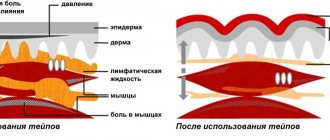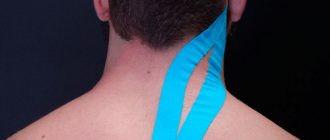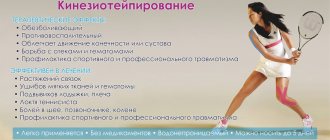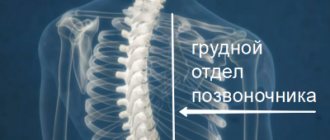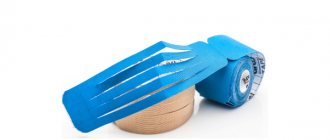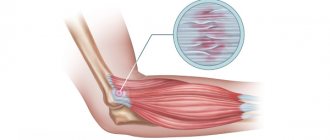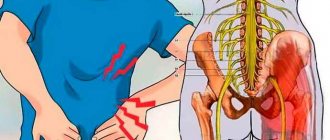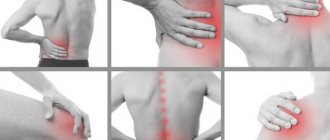Injuries in sports are common. An unsuccessful fall can cause severe pain in the upper spine. In this case, you can stick tape on your neck and prevent the development of inflammation. Fixing the muscles will reduce the load and help shorten the recovery period.
Flexible tapes can relieve unpleasant symptoms of chronic diseases such as osteochondrosis. Treatment of hernia and protrusion is not complete without taking medications. The kinesio technique will allow you to eliminate unnecessary chemicals.
A short and visual video shows how to carry out the application procedure correctly:
Types of tapes
There are tapes:
- Inelastic
- classic models that are made from 100% cotton without glue. Their task is mechanical fixation and support of muscles, ligaments, and tendons. - Elastic
- contain a large percentage of cotton, stretch in the longitudinal direction. This allows you to increase the degree of compression of the desired area. - Adhesive
– they are well fixed on any surface, which allows you to support joints and muscles even under heavy loads. - Cohesive
- they are glued only to another tape, used only to prepare a certain area for taping.
Tapes can have different shapes and sizes, which directly depends on their purpose, as well as on what areas they will be glued to. Products from different manufacturers differ in tension, weight, and elasticity. This places different levels of stress on your joints and muscles, so you need to know how to apply them. Universal kinesio tapes are used to treat hernias, stretch marks, and dislocations.
On sale you can find tapes of different shades. But the therapeutic effect does not depend on the color of the ribbon.
Contraindications
Using back tapes for osteochondrosis makes the manifestations of the disease less painful and helps the body recover. This technique is safe for use in both adults and children. The list of contraindications is small, but before using tapes we recommend consulting with your doctor.
Reasons for not taping:
- skin cancer;
- high blood pressure;
- chronic diseases.
What are the results after taping for a herniated disc?
After gluing, the tapes reduce the loosening of connective tissues, start the metabolic process, provoke the saturation of cells with oxygen, help regulate the movement of fluid in the tissues and the process of smoothing out adhesions. Creating rest for the injured area, they do not violate the integrity and mobility of the joints, do not limit movements, supporting the muscles.
Taping for hernia:
- improves blood circulation and lymph flow;
- limits the mobility of the damaged vertebra, which promotes its healing;
- relieves pain;
- increases muscle tone;
- relieves swelling;
- improves posture;
- reduces the risk of spinal injury during physical activity;
- gives the effect of a light massage.
Each type of intervertebral hernia has serious complications, so you should not delay treatment.
See how easy it is to get rid of a hernia in 10 sessions
Diagnostics
A comprehensive diagnostic study at the CELT clinic includes the following:
- examination by a Pain Clinic specialist, a neurologist, who will conduct a series of tests and make a preliminary diagnosis;
- instrumental examination (x-ray, magnetic resonance imaging, computed tomography), which allows you to clarify the data obtained during the examination, accurately determine the level of damage, identify the features of the pathology and its consequences for the spine.
Can everyone do taping?
Taping can be done to anyone diagnosed with a herniated disc. at any stage of the disease. The only limitation is that the procedure cannot be done during an exacerbation. It is recommended to combine this method of treatment with other physiotherapy procedures. For example, sticking tape after a massage prolongs the effect of the latter by 5 days.
Taping is used for any hernia of the spine:
- For lumbar and lumbosacral problems
- to relieve stress from the lower part of the spine and relax the back muscles. - For chest pain
– to fix the vertebrae and eliminate pain in the heart area. - For cervical
- to stabilize the cervical spine, relieve pressure from compressed nerves and blood vessels.
Taping can be done for lumbar, cervical and thoracic hernia
Advantages of the application
Even one session is enough to evaluate kinesio taping for neck pain. The advantages of the procedure are:
- Rigid fixation of the spine. The tape reduces the impact of the traumatic factor. The load stops straining the muscles.
- Relief of inflammation and pain. By stimulating the movement of blood and lymph, swelling subsides and discomfort disappears.
- Muscle relaxation. At rest, tissues recover faster. The regeneration process is accelerated.
No matter what methods of application are used: kinesio tapes for the neck help cope with pain and return to an active life. Moreover, the technique does not require serious knowledge. Just watch a video with an analysis of the tape application scheme.
Related publications
- Wrist taping: a simple technique
- Kinesio taping of the elbow joint
- Taping the lateral ligament of the knee
- Cohesive and adhesive tapes: areas of application
How to apply tapes for a hernia
If taping is performed by a person unfamiliar with the technique, the patient’s condition will worsen. Our specialists apply tapes using a special technique. Within 20 minutes the patient will feel the therapeutic effect. During the course of treatment, specialists monitor the patient’s health and the dynamics of the disease. If necessary, kinesiotaping is combined with other effective methods of hernia treatment.
General recommendations for gluing
Depending on the location of the herniated disc, the tapes are applied in the form of a snowflake, the letters X, Y, H. During the procedure, our specialist follows all the rules recommended for applying the tape:
- The tape is applied only to areas that bother the patient. It is not recommended to attach it in other places, so as not to weaken the tone of the back muscles.
- The tape is applied to bare, fat-free skin. If there is a lot of hair in the area where the tape will be applied, it is better to shave it off.
- The glued patch is smoothed by hand so that it adheres to the body.
- To reduce pain, the tape is glued along the inflamed nerve, removing its effect on nearby tissues.
- Kinesio tape is applied to the stretched skin. If it does not stretch well in this area, the tape is applied with a slight stretch (up to 50%).
- The first patch is applied to the line of the spinous processes of the vertebrae. The center of the tape should be above the hernia, the total length of the tape is 20-30 cm. The product is applied from top to bottom. Other patches are glued using a similar principle.
You can safely take a shower with the tape. The tape will get wet, but will dry quickly, will not rub, and will not peel off. Remove the strips with a special solution.
The location of application of the tape for a hernia of the lumbar spine and the technique of application are chosen by the doctor at our clinic depending on which area hurts.
Taping for lumbar and lumbosacral hernia
When taping the lower back for a hernia, the “snowflake” method is usually used, a tape 5 or 10 cm wide and 15-20 cm long.
The procedure follows this scheme:
- The doctor takes 4 tapes.
- The patient, sitting or standing, carefully leans forward so that the physician can fix the patch just below the line of the underwear.
- First, the doctor applies the first tape with gentle tension longitudinally to the muscle that straightens the back. Its center is located above the projection of the hernia.
- The second tape is placed perpendicular to it. As a result, a cross should form on the lower back.
- The third and fourth patches are glued diagonally, at an angle of 45 degrees.
- The person straightens up, the doctor smooths out the folds to securely fix the patch.
- You need to wear the bandage for 5 days, then change it.
There is also an option when tapes are applied in the form of two vertical strips located on both sides of the spinal column. They are connected from below by a decompression patch with a tension of 50-70%.
Taping for lumbar hernia in the form of two vertical stripes and using the “snowflake” method
Read all about lumbar hernias here.
Taping for thoracic hernia
Taping for a thoracic hernia requires knowledge and experience. The heart is located here, so inept actions will provoke arrhythmia, tachycardia, and other problems. Our clinic’s specialists are fluent in all taping techniques for thoracic hernia. One of the techniques we use looks like this:
- The tape is applied in the shape of a capital “X”, for which you take a tape 35 cm long.
- The top and bottom edges of the tape are folded and cut on both sides, leaving the middle.
- The patient takes a sitting position (it is not possible to apply the tape correctly while standing), arching his back so as to maximally stretch the muscles of the thoracic region.
- The uncut center of the tape is glued to the area with the hernia.
- The cut edges are rounded like a capital "X". They should run along the inside of the shoulder blade to target the trapezius muscle of the back.
- You need to wear the tape for 5 days, then change it.
Tape for a thoracic hernia is applied in the shape of a capital “X”
Read more about the symptoms and treatment of thoracic hernias here.
Taping for cervical hernia
Tapes for cervical hernia are applied with extreme caution. Incorrect actions can worsen the situation and even deprive the patient of mobility. We use several methods of tape application. The choice of technique depends on the vertebra where the hernia popped out, and which nerves it affected.
One technique looks like this:
- The patch is applied in the form of an “H”, for which 2 tapes 20 cm long and 1 tape 15 cm long are taken.
- Long tapes are applied parallel to each other along the spine.
- A short tape is used to connect the pasted patches, applying the glue perpendicular to the spine.
Read more about other methods of treating cervical hernia in this article.
You can also apply tapes in the form of the letter “V”, which is crossed at the top by a horizontal line:
- The main patch is applied to the neck on one side of the spinal column without strong tension. The lower edge should be located above the hernia.
- The second patch below is attached to the first one above the hernia. Up comes from the other side of the spinal column.
- The third patch connects the 2 tapes from above, positioned horizontally along the spinous process of the 7th cervical vertebra.
- Then the patches are rubbed for reliable adhesion.
- Tapes are worn for a maximum of 5 days, then changed.
Tape for cervical hernia is applied in the form of the letter “V” or “H”
Application instructions
First you need to take the correct body shape:
- Sit down.
- Give up.
- Straighten your back.
- Tilt your head forward.
The next step is choosing the optimal tape length. Then you need to round the edges, otherwise the sharp corners will cling to clothing or equipment.
Now we’ll tell you how to properly apply tapes to your neck. There are three common schemes:
- Apply a couple of patches on both sides of the spine in parallel.
- Cut 2 wide tapes into 3 parts and stick them crosswise.
- Fix one V-shaped tape directly on the line of the spinous processes.
In addition to the vertical segments, you need at least one horizontal one. It further reduces the load on the muscles and bones of the musculoskeletal system.
All three schemes are shown in the photo. Which one is right? It is better to ask this question to a medical practitioner.
Duration of impact
For athletes, it is important that kinesio taping of the neck does not cause long-term refusal to train. Elastic bands are not afraid of water, which means the paths to the pool and shower are open. There is no need to change the patches after they get wet. They dry quickly and retain their shape.
The minimum “shelf life” of an application is 3 days, and the maximum is 5. This time is quite enough so as not to go broke purchasing material. But excessive savings should be avoided. One sticker is clearly not enough for a week.
Remove the tape correctly
After 5 days, the patch needs to be replaced.
When the tapes have served their purpose, you should not make sudden movements. The polymer layer of adhesive can damage the skin when torn off. Sports stores sell impregnation intended for such cases. You can use it:
- Moisten the tapes evenly along the entire length.
- Wait 3-5 minutes.
- Carefully remove the patch along the hair growth.
A moisturizer will help restore skin tone after the procedure.
How to remove tapes from the back with a hernia
If you try to remove the tape with a jerk, you risk being left without skin. The glue applied to the tapes is very tenacious and resistant to water. A special spray or liquid will help you remove the patch painlessly. It’s even better to contact our clinic, where a specialist will quickly and easily remove the tape and, if necessary, apply a new one.
The tape is removed according to this scheme:
- The spray is applied to the patch, wait 3-4 minutes for the glue to soften and lose its tenacity.
- The tape should be removed slowly, in the direction of hair growth.
- After removing the tape, the skin is moisturized with cream.
What types of intervertebral hernias are most difficult to treat?
4 stages of treatment for intervertebral hernia
Contraindications
Tapes cannot be applied if an allergic reaction occurs after gluing the tape - redness, skin irritation, severe itching. In this case, the tapes must be removed immediately. Alternatively, you can try using a patch from another manufacturer.
Other contraindications:
- Acute pain. Tapes are applied only at the stage of remission.
- Wounds, skin irritations, benign tumors in the area where the tape is applied.
- Systemic skin diseases that reduce its ability to stretch.
- Postoperative period after surgical manipulations on the spine (until complete healing).
- Diseases of the heart, kidneys, which provoked the appearance of edema.
- Cardiac ischemia, recent heart attack, stroke, as well as the condition that precedes them.
- Pathological changes in the carotid artery – atherosclerosis. Due to the application of tape, a piece of cholesterol plaque may come off and clog the vessel.
- Diabetes mellitus, which reduces skin healing.
- Malignant formations (oncology) – application of tapes can stimulate the spread of metastases.
- Open and closed hemorrhages. Tapes improve blood flow, which in this case can be dangerous.
- Severe infectious, mental, neurological diseases.
Permissions and prohibitions
There are diseases for which taping for neck pain is justified. For example, chronic disorders in the initial stage. Here is a list of indications:
- Pain and clicking when moving the head.
- Feeling of stiffness, ossification.
- There's a pain in the back of my head.
- Numbness between the shoulder blades.
- Sprain, bruise.
- Osteochondrosis.
- Headache.
The main cause of unpleasant symptoms is a pinched nerve. Deformed vertebrae put pressure on areas of the spinal cord, causing muscle spasms, disruption of blood flow and lymph movement.
There are contraindications for the kinesiological method of pain relief:
- Thrombosis. The slightest pressure on soft tissue leads to the formation of blood clots.
- Damage to the skin. If you apply kinesio tape to a neck covered with wounds, it will take a long time to recover.
- Dermatoses. Do not apply the patch to the affected areas, as this will worsen the disease.
- Oncology. Any careless intervention can cause the growth of malignant tumors.
- Tumors. In this case, the pressure of the tape increases the pathological area.
- Diabetes. Malaise provokes complex disorders. Any intervention is dangerous.
- Reflux disease. A weakened body should be treated with caution. You need to consult a doctor.
- Impaired kidney function. The disease causes fluid stagnation. When muscles are tightened, swelling may occur.
Neck taping is not recommended for pregnant women. A high temperature is also a reason to temporarily abandon the procedure.
FAQ
Is it possible to glue tapes at home?
No, only a specialist should do this. He knows how the spine works, is able to determine the dislocation of the hernia, and which kinesiotaping technique is suitable in each case. In addition, there are many tapes on sale that have different composition, elasticity, and purpose. You need to know about all this. Incorrect exposure of the tape will cause deterioration and complications.
Is it possible to apply tapes after hernia surgery?
Immediately after surgery - no. Taping can only be done during the rehabilitation period, with the permission of the attending physician.
Will tapes help get rid of hernia pain?
Yes, taping accelerates local blood flow, reduces the pressure of the hernia on the spinal cord, and relieves the load on the intervertebral disc. All this contributes to its healing. The only point is that the patch cannot be applied during periods of acute pain. Only during remission.
Our clinic has developed a unique method for treating hernia using kinesio taping. When applying tapes, our doctors take into account the location of fixation, tension force, angle of impact and many other factors. Contact us if you have any muscle discomfort or exacerbation of the disease. For a speedy recovery of the patient, we can combine taping with drug therapy, herbal medicine and other effective methods of oriental medicine.
We use non-surgical hernia treatment techniques
Read more about our unique technique
Read about other methods of treating hernias in our article “Treatment of intervertebral hernia.”
Literature:
- Kiselev D.A., Kinesiotaping in the medical practice of neurology and orthopedics”;
- Kasatkin M. S., “Clinical guidelines for kinesiological taping”;
- Pirogova L.A., “Kinesitherapy and massage”
- Subbotin F. A., “Propaedeutics of functional therapeutic kinesiotaping”;
- Kaganovich M.S., “Introduction to kinesiological taping.”
Themes
Intervertebral hernia, Spine, Pain, Treatment without surgery Date of publication: 02/15/2021 Date of update: 03/16/2021
Reader rating
Rating: 5 / 5 (1)
Recommendations for patients
- adherence to the principles of a healthy and rational diet: excess weight increases the load on the spine;
- Sitting in one position for a long time or carrying a bag or other load on one shoulder is unacceptable;
- regular exercise. Swimming lessons are recommended at least once a week.
Application with kinesio tapes provides a unique opportunity to effectively treat osteochondrosis without limiting a person’s motor activity. The use of the patch helps to quickly eliminate pain and restore normal functioning of the cervical spine after the first use.
